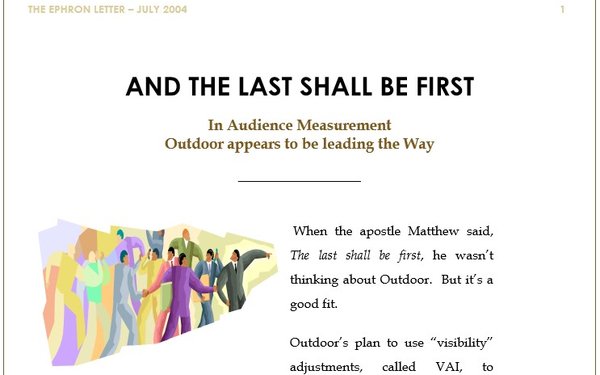
The
advertising industry has spawned amazing visionaries, but it is hard to match the wisdom of the late, great Erwin Ephron. He has been called “the father of modern media planning,”
and “the inventor of ‘recency,’” and, as the anniversary of his death approaches, I’ve been thinking about how valuable his contributions to measurement have been.
With Ephron’s input, the industry made the leap forward from daily effective circulation (DECs, also known as “opportunity-to-see” impressions) to the likelihood-to-see
impressions used today.
Pierre Bouvard, a fellow media researcher (now Chief Insights Officer at Cumulus Media, Westwood One), ran quite a number of studies on behalf of
the out-of-home industry and shares my reverence for Ephron's vision. Bouvard generously shared an article that Ephron penned in July 2004, titled “And The Last Shall Be First: In Audience
Measurement, Outdoor appears to be leading the Way.”
advertisement
advertisement
Despite rapid technological innovation and disruption across the industry, Ephron’s words remain as true today as
they were when he first wrote them 15 years ago.
Erwin stated: “Outdoor’s plan to use ‘visibility’ adjustments, called VAI, to measure the number of
consumers who actually see a billboard, shames all of the other media exposure numbers we plan and buy with.”
Likelihood-to-see impressions aren’t just the gold
standard globally. These metrics are vital as we embrace audience-based buying. Utilizing opportunity-to-see impressions, an ad on the back of a bench may receive the same number of
“impressions” as the billboard next to it -- despite it being more likely for passersby to see the billboard.
If you put this scenario into a blind, impression-based,
programmatic platform, the bench will have a significantly lower CPM and typically be bought instead of the bulletin. Larger formats would be negatively impacted, while smaller formats artificially
benefit.
Inflated audience metrics also negatively impact the entire channel and lead to ROI/campaign effectiveness studies that show the channel underperforms.
Ephron believed embracing likelihood-to-see impressions makes it easier to buy and sell out-of-home advertising. I agree. Prior to the introduction of the VAI, agencies and advertisers
were discounting the opportunity-to-see (OTS) impressions based on their own proprietary evaluations of inventory factors such as size.
Ephron was puzzled that this was not
embraced across more media formats. “An adjustment for unit size, for example, works across all media, not just Outdoor, why not use it? The idea that we do not adjust Print OTS for the use of
fractional units is puzzling. The idea that we do not adjust TV OTS for length of message, 15’s versus 30’s, is inexcusable,” he wrote.
I recently spoke on a
cross-platform measurement panel at the Advertising Research Foundation’s AUDIENCExSCIENCE conference, alongside media research leaders from across the industry. We discussed the gap between the
opportunity to see an ad and actual consumption of that ad. I was happy to hear Ephron’s beliefs being espoused on stage and pleasantly surprised when the audience called for all channels to be
measured as responsibly as OOH.
I continue to support the value of the likelihood-to-see impression and am deeply grateful to Ephron and my committee members who pushed for
the use of this more valuable metric.
“Outdoor is, hands-down, the most exciting medium around.” — Erwin Ephron
Erwin Ephron
passed away peacefully on Oct. 13, 2013.